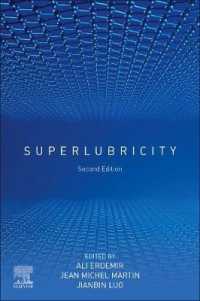- ホーム
- > 洋書
- > 英文書
- > Science / Mathematics
Full Description
Hands-on Data Science for Biologists using Python has been conceptualized to address the massive data handling needs of modern-day biologists. With the advent of high throughput technologies and consequent availability of omics data, biological science has become a data-intensive field. This hands-on textbook has been written with the inception of easing data analysis by providing an interactive, problem-based instructional approach in Python programming language.
The book starts with an introduction to Python and steadily delves into scrupulous techniques of data handling, preprocessing, and visualization. The book concludes with machine learning algorithms and their applications in biological data science. Each topic has an intuitive explanation of concepts and is accompanied with biological examples.
Features of this book:
The book contains standard templates for data analysis using Python, suitable for beginners as well as advanced learners.
This book shows working implementations of data handling and machine learning algorithms using real-life biological datasets and problems, such as gene expression analysis; disease prediction; image recognition; SNP association with phenotypes and diseases.
Considering the importance of visualization for data interpretation, especially in biological systems, there is a dedicated chapter for the ease of data visualization and plotting.
Every chapter is designed to be interactive and is accompanied with Jupyter notebook to prompt readers to practice in their local systems.
Other avant-garde component of the book is the inclusion of a machine learning project, wherein various machine learning algorithms are applied for the identification of genes associated with age-related disorders. A systematic understanding of data analysis steps has always been an important element for biological research. This book is a readily accessible resource that can be used as a handbook for data analysis, as well as a platter of standard code templates for building models.
Contents
Python: Introduction and Environment Set up. Basic Python Programming. Biopython. Python for Data Analysis. Python for Data Visualization. Principal Component Analysis. Hands-on Projects. Machine Learning and Linear Regression. Logistic Regression. K-Nearest Neighbors (K-NN). Decision Trees and Random Forests. Support Vector Machines. Neural Nets and Deep Learning. The Machine Learning Project. Natural Language Processing. K-Means Clustering.








